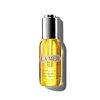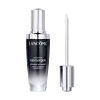What's inside
What's inside
 Key Ingredients
Key Ingredients

 Benefits
Benefits

 Concerns
Concerns

 Ingredients Side-by-side
Ingredients Side-by-side

Limnanthes Alba Seed Oil
Skin ConditioningDimethicone
EmollientCaprylic/Capric Triglyceride
MaskingWater
Skin ConditioningTrisiloxane
Skin ConditioningPrunus Amygdalus Dulcis Oil
Skin ConditioningSimmondsia Chinensis Seed Oil
EmollientPolydecene
Skin ConditioningHydrogenated Polydecene
EmollientButylene Glycol
HumectantPropanediol
SolventGlycerin
HumectantAlgae Extract
EmollientBrassica Campestris Seed Oil
Skin ConditioningHelianthus Annuus Seed Oil
EmollientSesamum Indicum Seed Oil
EmollientEucalyptus Globulus Leaf Oil
PerfumingCamelina Sativa Seed Oil
Skin ConditioningOxycoccus Palustris Seed Oil
AntioxidantOlea Europaea Fruit Oil
MaskingHippophae Rhamnoides Oil
EmollientMedicago Sativa Seed Powder
Skin ConditioningHelianthus Annuus Seedcake
AbrasivePrunus Amygdalus Dulcis Seed Meal
AbrasiveSodium Gluconate
Skin ConditioningCopper Gluconate
Skin ConditioningCalcium Gluconate
HumectantMagnesium Gluconate
Skin ConditioningZinc Gluconate
Skin ConditioningTocopheryl Succinate
AntioxidantNiacin
SmoothingSesamum Indicum Seed Powder
Skin ConditioningLaminaria Ochroleuca Extract
Skin ConditioningLaminaria Saccharina Extract
Skin ProtectingHydrolyzed Algin
Sea Salt
AbrasiveChlorella Vulgaris Extract
Skin ConditioningSalicornia Herbacea Extract
Skin ConditioningSigesbeckia Orientalis Extract
Skin ConditioningLaminaria Digitata Extract
Skin ProtectingRosmarinus Officinalis Leaf Extract
AntimicrobialMagnolia Officinalis Bark Extract
AntimicrobialYeast Extract
Skin ConditioningCrithmum Maritimum Extract
Skin ConditioningCommiphora Mukul Resin Extract
Skin ConditioningCitrus Aurantifolia Peel Extract
CleansingMolasses Extract
Skin ConditioningSucrose
HumectantAcetyl Hexapeptide-8
HumectantAcetyl Glucosamine
Skin ConditioningCaffeine
Skin ConditioningTocopheryl Acetate
AntioxidantPhenyl Trimethicone
Skin ConditioningSodium Chloride
MaskingTetrahexyldecyl Ascorbate
AntioxidantAlcohol Denat.
AntimicrobialParfum
MaskingHexyl Cinnamal
PerfumingLinalool
PerfumingAmyl Cinnamal
PerfumingGeraniol
PerfumingLimonene
PerfumingCitral
PerfumingBenzyl Benzoate
AntimicrobialCoumarin
PerfumingCitronellol
PerfumingBHT
AntioxidantPhenoxyethanol
PreservativeCI 19140
Cosmetic ColorantCI 15985
Cosmetic ColorantLimnanthes Alba Seed Oil, Dimethicone, Caprylic/Capric Triglyceride, Water, Trisiloxane, Prunus Amygdalus Dulcis Oil, Simmondsia Chinensis Seed Oil, Polydecene, Hydrogenated Polydecene, Butylene Glycol, Propanediol, Glycerin, Algae Extract, Brassica Campestris Seed Oil, Helianthus Annuus Seed Oil, Sesamum Indicum Seed Oil, Eucalyptus Globulus Leaf Oil, Camelina Sativa Seed Oil, Oxycoccus Palustris Seed Oil, Olea Europaea Fruit Oil, Hippophae Rhamnoides Oil, Medicago Sativa Seed Powder, Helianthus Annuus Seedcake, Prunus Amygdalus Dulcis Seed Meal, Sodium Gluconate, Copper Gluconate, Calcium Gluconate, Magnesium Gluconate, Zinc Gluconate, Tocopheryl Succinate, Niacin, Sesamum Indicum Seed Powder, Laminaria Ochroleuca Extract, Laminaria Saccharina Extract, Hydrolyzed Algin, Sea Salt, Chlorella Vulgaris Extract, Salicornia Herbacea Extract, Sigesbeckia Orientalis Extract, Laminaria Digitata Extract, Rosmarinus Officinalis Leaf Extract, Magnolia Officinalis Bark Extract, Yeast Extract, Crithmum Maritimum Extract, Commiphora Mukul Resin Extract, Citrus Aurantifolia Peel Extract, Molasses Extract, Sucrose, Acetyl Hexapeptide-8, Acetyl Glucosamine, Caffeine, Tocopheryl Acetate, Phenyl Trimethicone, Sodium Chloride, Tetrahexyldecyl Ascorbate, Alcohol Denat., Parfum, Hexyl Cinnamal, Linalool, Amyl Cinnamal, Geraniol, Limonene, Citral, Benzyl Benzoate, Coumarin, Citronellol, BHT, Phenoxyethanol, CI 19140, CI 15985
Water
Skin ConditioningBifida Ferment Lysate
Skin ConditioningGlycerin
HumectantAlcohol Denat.
AntimicrobialDimethicone
EmollientHydroxyethylpiperazine Ethane Sulfonic Acid
BufferingAscorbyl Glucoside
AntioxidantSodium Hyaluronate
HumectantSodium Hydroxide
BufferingSodium Benzoate
MaskingPhenoxyethanol
PreservativeAdenosine
Skin ConditioningFaex Extract
Skin ConditioningPEG-20 Methyl Glucose Sesquistearate
EmulsifyingPEG-60 Hydrogenated Castor Oil
EmulsifyingSalicyloyl Phytosphingosine
Skin ConditioningAmmonium Polyacryloyldimethyl Taurate
Emulsion StabilisingLimonene
PerfumingXanthan Gum
EmulsifyingCaprylyl Glycol
EmollientDisodium EDTA
Octyldodecanol
EmollientCitronellol
PerfumingParfum
MaskingWater, Bifida Ferment Lysate, Glycerin, Alcohol Denat., Dimethicone, Hydroxyethylpiperazine Ethane Sulfonic Acid, Ascorbyl Glucoside, Sodium Hyaluronate, Sodium Hydroxide, Sodium Benzoate, Phenoxyethanol, Adenosine, Faex Extract, PEG-20 Methyl Glucose Sesquistearate, PEG-60 Hydrogenated Castor Oil, Salicyloyl Phytosphingosine, Ammonium Polyacryloyldimethyl Taurate, Limonene, Xanthan Gum, Caprylyl Glycol, Disodium EDTA, Octyldodecanol, Citronellol, Parfum
 Reviews
Reviews

Ingredients Explained
These ingredients are found in both products.
Ingredients higher up in an ingredient list are typically present in a larger amount.
Alcohol Denat. is an alcohol with a denaturant property. It is created by mixing ethanol with other additives.
This ingredient gets a bad rep because it is irritating and drying - mostly due to its astringent property. Astringents draw out natural oils in tissue, constricting pores and leaving your skin dried out.
However, alcohol denat. is not all that bad.
Due to its low molecular weight, alcohol denat. tends to evaporate quickly. One study on pig skin found half of applied alcohol evaporated in 10 seconds and less than 3% stayed on skin.
This also helps other ingredients become better absorbed upon application.
Studies are conflicted about whether this ingredient causes skin dehydration. One study from 2005 found adding emollients to propanol-based sanitizer decreased skin dryness and irritation. Another study found irritation only occurs if your skin is already damaged.
Small amounts of alcohol are generally tolerated by oily skin or people who live in humid environments.
The rule of thumb is if this alcohol is near the end of an ingredients list, it will probably not affect your skin much.
Also...
This ingredient has antimicrobial and solvent properties.
The antimicrobial property helps preserve products and increase their shelf life. As a solvent, it helps dissolve other ingredients.
Other types of astringent alcohols include:
Learn more about Alcohol Denat.Citronellol is used to add fragrance/parfum to a product. It is often derived from plants such as roses. In fact, it can be found in many essential oils including geranium, lavender, neroli, and more. The scent of Citronellol is often described as "fresh, grassy, and citrus-like".
Since the Citronellol molecule is already unstable, Citronellol becomes irritating on the skin when exposed to air.
Citronellol is a modified terpene. Terpenes are unsaturated hydrocarbons found in plants. They make up the primary part of essential oils.
Citronellol is not able to be absorbed into deeper layers of the skin. It has low permeability,
Citronellol is also a natural insect repellent.
Learn more about CitronellolDimethicone is a type of synthetic silicone created from natural materials such as quartz.
What it does:
Dimethicone comes in different viscosities:
Depending on the viscosity, dimethicone has different properties.
Ingredients lists don't always show which type is used, so we recommend reaching out to the brand if you have questions about the viscosity.
This ingredient is unlikely to cause irritation because it does not get absorbed into skin. However, people with silicone allergies should be careful about using this ingredient.
Note: Dimethicone may contribute to pilling. This is because it is not oil or water soluble, so pilling may occur when layered with products. When mixed with heavy oils in a formula, the outcome is also quite greasy.
Learn more about DimethiconeGlycerin is already naturally found in your skin. It helps moisturize and protect your skin.
A study from 2016 found glycerin to be more effective as a humectant than AHAs and hyaluronic acid.
As a humectant, it helps the skin stay hydrated by pulling moisture to your skin. The low molecular weight of glycerin allows it to pull moisture into the deeper layers of your skin.
Hydrated skin improves your skin barrier; Your skin barrier helps protect against irritants and bacteria.
Glycerin has also been found to have antimicrobial and antiviral properties. Due to these properties, glycerin is often used in wound and burn treatments.
In cosmetics, glycerin is usually derived from plants such as soybean or palm. However, it can also be sourced from animals, such as tallow or animal fat.
This ingredient is organic, colorless, odorless, and non-toxic.
Glycerin is the name for this ingredient in American English. British English uses Glycerol/Glycerine.
Learn more about GlycerinLimonene is a fragrance that adds scent and taste to a formulation.
It's found in the peel oil of citrus fruits and other plants such as lavender and eucalyptus. The scent of limonene is generally described as "sweet citrus".
Limonene acts as an antioxidant, meaning it helps neutralize free radicals.
When exposed to air, oxidized limonene may sensitize the skin. Because of this, limonene is often avoided by people with sensitive skin.
The term 'fragrance' is not regulated in many countries. In many cases, it is up to the brand to define this term. For instance, many brands choose to label themselves as "fragrance-free" because they are not using synthetic fragrances. However, their products may still contain ingredients such as essential oils that are considered a fragrance.
Learn more about LimoneneParfum is a catch-all term for an ingredient or more that is used to give a scent to products.
Also called "fragrance", this ingredient can be a blend of hundreds of chemicals or plant oils. This means every product with "fragrance" or "parfum" in the ingredients list is a different mixture.
For instance, Habanolide is a proprietary trade name for a specific aroma chemical. When used as a fragrance ingredient in cosmetics, most aroma chemicals fall under the broad labeling category of “FRAGRANCE” or “PARFUM” according to EU and US regulations.
The term 'parfum' or 'fragrance' is not regulated in many countries. In many cases, it is up to the brand to define this term.
For instance, many brands choose to label themselves as "fragrance-free" because they are not using synthetic fragrances. However, their products may still contain ingredients such as essential oils that are considered a fragrance by INCI standards.
One example is Calendula flower extract. Calendula is an essential oil that still imparts a scent or 'fragrance'.
Depending on the blend, the ingredients in the mixture can cause allergies and sensitivities on the skin. Some ingredients that are known EU allergens include linalool and citronellol.
Parfum can also be used to mask or cover an unpleasant scent.
The bottom line is: not all fragrances/parfum/ingredients are created equally. If you are worried about fragrances, we recommend taking a closer look at an ingredient. And of course, we always recommend speaking with a professional.
Learn more about ParfumPhenoxyethanol is a preservative that has germicide, antimicrobial, and aromatic properties. Studies show that phenoxyethanol can prevent microbial growth. By itself, it has a scent that is similar to that of a rose.
It's often used in formulations along with Caprylyl Glycol to preserve the shelf life of products.
Water. It's the most common cosmetic ingredient of all. You'll usually see it at the top of ingredient lists, meaning that it makes up the largest part of the product.
So why is it so popular? Water most often acts as a solvent - this means that it helps dissolve other ingredients into the formulation.
You'll also recognize water as that liquid we all need to stay alive. If you see this, drink a glass of water. Stay hydrated!
Learn more about Water